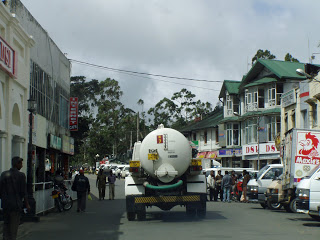Practitioner's Tool / Septage Transportation
Septage transportation includes all activities from the time a septic tank is pumped to the time the septage load arrives at the treatment facility. The driver and service providers are responsible for safe operation of the vehicle and equipment. Traffic rules shall be followed at all times. All accidents and citations shall be reviewed and investigated by management to ensure adequately trained and competent drivers are employed for septage and sludge transportation.
Additional requirements include the following:
- All truck-mounted tanks shall be inspected by the driver prior to transport on public roads to ensure that septage will not leak, spill, or run out of the tank.
- All vehicles used to transport the septage shall be equipped at all times with spill control or absorbent materials and disinfecting agents, such as lime or chlorine bleach.
- No discharge of septage or sludge shall be allowed in manholes, drainage areas, canals, creeks, rivers or other receiving bodies of water or land. Septage must be disposed of in an approved location or facility.
- Recordkeeping and manifesting requirements must be complied with.
The septage receiving station at Manila Water's South Septage Treatment Plant is shown to the left. The station is equipped with a flow meter, an electronic sign-in entry keypad, and a washdown station. Everything is provided to make the delivery easier, safer and faster for the septage truck operator. Operators at this facility require load manifests from the drivers certifying the origin of the septage. This facility is designed only for residential septage, so commercial loads that may be high in grease or chemicals are excluded. In order to enforce this, operators will often require a sample to be taken from the tanker trucks before permission is granted to connect to the unloading system. Experienced operators can learn a lot from simply looking at a sample: it should be brown or black in color with no separation of grease or oil floating on top of the sample. There is an on-site laboratory at this facility in Manila should analytical testing be required.
The South Septage Treatment Plant is operated with the goal of meeting or exceeding standards of international best practices. International Organization for Standardization (ISO) certifications are pending.
Operating logs are maintained to provide ready information about the number of trucks, total volume of septage received, and special circumstances that the treatment plant operator should be aware of. The South Septage Treatment Plant operates 24 hours a day, so operations logs are an important means of communicating operating conditions from one shift to the next.
Manual Discharging is still used at many septage treatment facilities with no electronic unloading stations. In this case, all discharge must be manually performed. Drivers should chock their wheels before connecting the hose to the truck. Most manual operations are performed using gravity, so the pump is not engaged; this can be a lengthy process. It is good practice during the unloading time for drivers to inspect their trucks, tanks and equipment for any leaks or other mechanical problems.


